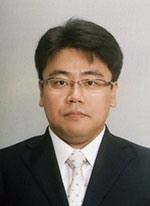
Electronics, Communications and Networks


Biography: Yutaka Fukuchi was born in Tochigi, Japan, on April 29, 1975. He received the B.S. and M.S. degrees in electronics engineering from Tokyo University of Science, Chiba, Japan, in 1998 and 2000, respectively, and the Ph.D. degree in electronics engineering from the University of Tokyo, Tokyo, Japan, in 2003.
In 2003, he joined the Department of Electrical Engineering, Faculty of Engineering, Tokyo University of Science, Tokyo, Japan as an Assistant Professor. From 2003 to 2005, he was also a Co-operative Research Fellow in Research Center for Advanced Science and Technology, the University of Tokyo, Tokyo, Japan. Then, he became a Junior Associate Professor of Tokyo University of Science in 2006. Since 2009, he has been an Associate Professor at this university. From 2013 to 2014, he was a Visiting Research Fellow with the High-Speed Optical Communications Group, Department of Photonics Engineering, Technical University of Denmark, Lyngby, Denmark. His research interests are optical communications, quantum optics, nonlinear optics, and their applications.
Dr. Fukuchi is a member of the Institute of Electrical and Electronics Engineers (IEEE), the Optical Society of America (OSA), and the Institute of Electronics, Information, and Communication Engineers (IEICE).
Speech Title: Technique of Generating Flat Frequency Combs and Short Pulses from a Harmonically Mode-Locked Bismuth-Based Fiber Ring Laser
Abstract: Optical frequency comb laser sources can offer many attractive and useful applications such as wideband multi-wavelength lasers, ultra-short pulse generation, ultra-fast signal processing, coherent waveform syntheses, high resolution spectroscopy, astronomical spectrograph calibration, and optical frequency reference. High coherence, high efficiency, high stability, low noise, low cost, simple structure, wide bandwidth, and good spectral flatness are commonly required for those solutions.
In the past, several proposals for optical frequency comb generation have been reported. Mode-locking based on the fiber-optic or semiconductor technologies and pulse compression or spectral broadening through the nonlinear process based on four-wave mixing or self-phase modulation in the third-order nonlinear devices are usually employed for realizing the optical frequency comb generation. Recently, owing to the improvement in the electrical bandwidth and the decrease in the driving voltage of the electro-optic modulators, stable optical frequency comb generation using electro-optic modulation of a continuous-wave semiconductor laser has also been proposed and demonstrated.
Among many potential frequency comb laser sources, harmonically mode-locked fiber ring lasers are a popular solution because of their abilities such as wide wavelength tunability, short pulse width, small timing jitter, and high repetition frequency in the gigahertz region. However, since the harmonically mode-locked fiber ring lasers commonly use silica-based erbium-doped fibers as the intracavity gain media, the range of the wavelength tuning is limited either to the conventional wavelength band region or the longer wavelength band region. The tunable wavelength range is very important issue of the optical frequency comb generators for the practical applications. In addition, it is generally difficult for each optical frequency comb component generated by the harmonically mode-locked fiber ring lasers to have the same intensity. One of the most difficult challenges in the harmonically mode-locked fiber ring lasers is how to generate a spectrally flattened frequency comb.
In this paper, we review a technique for producing a tunable and flat optical frequency comb from a harmonically mode-locked bismuth-based fiber ring laser. A bismuth-oxide-based erbium-doped fiber with a length of 1.5 meters and a bismuth-oxide-based highly nonlinear fiber with a length of 4.1 meters are used as a broadband gain medium and a flatly spectral broadening device in the cavity, respectively. A wavelength-tunable and bandwidth-variable filter is used for an intracavity filter.